How to Stay Creative When Regularly Shooting Weddings
![]()
I love being a wedding photographer. I get to work with amazing couples, travel to incredible places and do something that is fundamentally creative. While weddings offer unparalleled opportunities for creativity due to the nature of shooting so many different people in different places, there are things I consciously keep in mind to make sure I mix things up and have the best chances of always remaining creative… no matter where I am.
Equipment, inspiration, and learning
Before even picking up a camera, it’s worth considering what you do when you’re not shooting weddings, just as much as when you are. For me, there are three key things I do when I’m not shooting to keep my creativity levels topped up:
1. Keep your gear up to date
Never underestimate what a change in equipment can do to keep you on your toes. I didn’t start shooting weddings until I had two full-frame Nikon cameras (D750s) and a good range of pro-level, fast glass (which were f/2.8 minimum) to give me variety and flexibility. However, it wasn’t until recently that I had the chance to shoot using the latest Nikon DSLR, the D850. After I’d shot the first wedding with it, I was seriously impressed by the results and what I was able to achieve. The D850 was able to handle low light better than any camera I’d ever shot with before, changing how I then approached the next wedding I went to.
2. Look for inspiration
Spending time browsing Instagram, Pinterest and the websites of other photographers can help spark seriously creative ideas. The process of looking at other photographers’ work and relating that to your own is sure to get creative juices flowing and open the mind to what’s possible.
3. Never stop learning
Through learning, whether that’s by watching videos, reading books, doing training courses online or in person, you are much more likely to be able to keep fresh and remain relevant.
It’s all about how you approach it
When it comes to shooting weddings creatively, the most important thing you can do is mix up your approach. Here are the eight things that I do when I’m shooting weddings (and engagement shoots) that help me keep my photography fresh.
1. Lean into the obstacle
A big complaint I regularly hear is about the light being ‘too harsh’ to shoot in. My view is that it’s better to figure out how you can take control of a situation and turn it to your own advantage.
At a recent wedding I shot, it was a fiercely bright day and the backdrop I had chosen beforehand left the couple squinting. Instead of looking for softer light somewhere else, I told them to close their eyes and look upwards as if they were sunning themselves. This resulted in an image where the bride and groom look peaceful and content – and it’s now one of my favorite shots of the year so far.
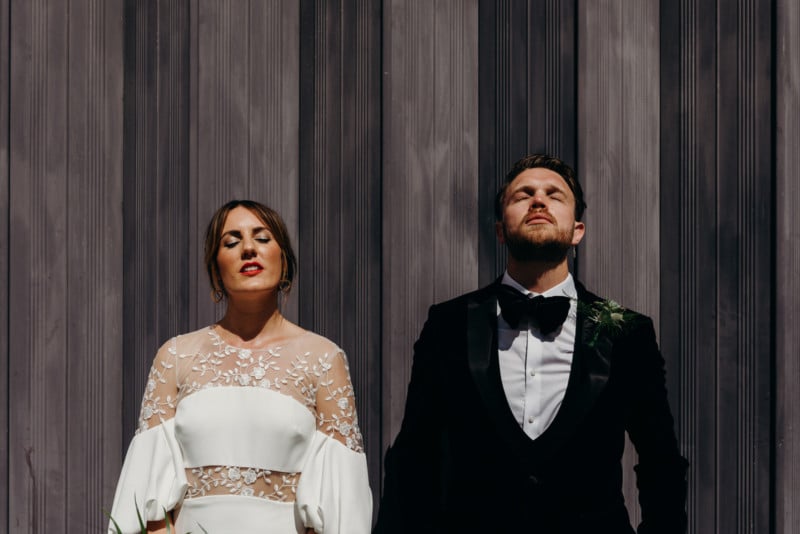
2. Shoot through the moment
Those ‘magic moments’ that happen at weddings are always part of a wider story or sequence of things happening in quick succession. When you notice these moments, resist the urge to look at the back of your camera. Keep focused, shoot through the moment, and stay present. You might find you’ll get more than one worthwhile moment, or you could come away with a number of beautiful photos that tell the story better than one single frame ever could.
3. Go where the herd doesn’t
So many elements of wedding photography have progressed from originally being new and on-trend, to overdone, to eventually being cliché. Finding a different angle on a moment that’s been shot thousands of times before is challenging, but it is possible. You can see this in action from a wedding I shot in India earlier this year; a scrum of photographers and videographers on one side of the groom and me on the opposite side.
Three things were going through my head here: I don’t want the same photos as everyone else, I don’t want the flat cold light of that LED panel in my photos and… there’s no room for me over there. So, I squeezed in on the other side, confident that the dynamic range of my D850 and the wide angle of my AF-S NIKKOR 28mm f/1.4E ED lens would let me capture the scene, using the LED panel as a backlight while still capturing all the detail in the shadows.
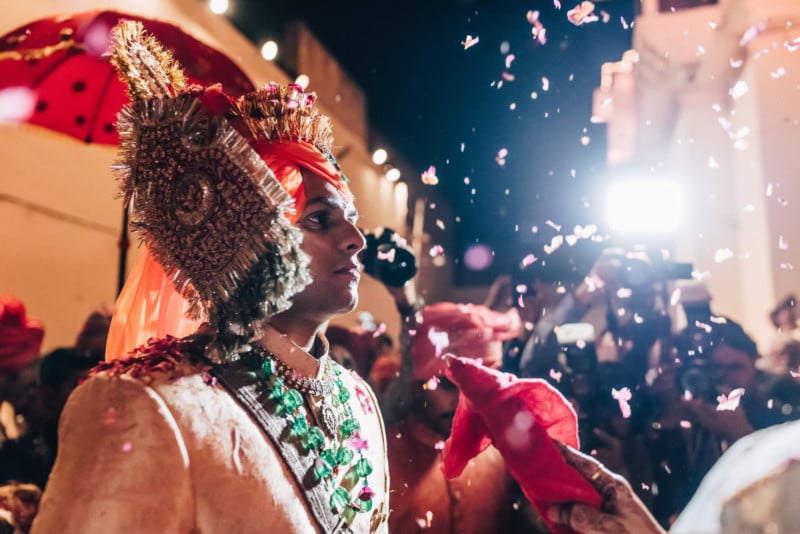
4. Borrow from other disciplines
Before becoming a wedding photographer, I loved shooting landscapes and experimenting with long exposures. Now that weddings take up most of my time, the only chance I really get to enjoy this type of photography is when I’m at a wedding. When caught up in the midst of shooting everything else, ask yourself if you can be a different photographer for a moment. Can you shoot the scene as a landscape (that just so happens to have a couple in it)? Can you shoot the reception marquee at night, on a tripod, to capture a long exposure? The possibilities are limitless.
5. Go further…
Sometimes, it’s worth going the extra mile – literally – to find that winning image the couple will treasure forever. For one wedding I shot in Bavaria, the couple wanted to do portraits at a nearby lake. In preparation for the day itself, I did my research (mostly on Google Maps) to find the best spot for the shoot. After the ceremony was over we drove 20 minutes then hiked for half an hour to the spot in the image. It was exhausting but worth the extra effort.
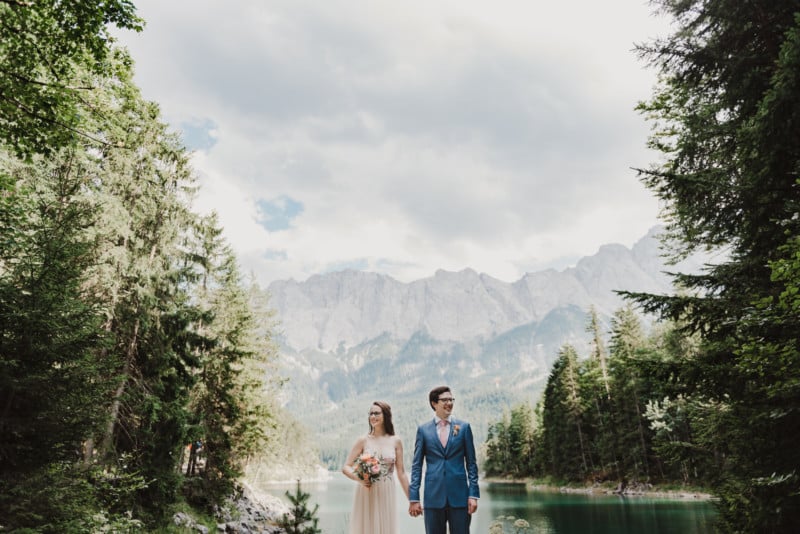
6. Keep on the move
There’s a saying: “if you stay in one place long enough, you’ll never go anywhere” and this is certainly true when shooting weddings. Keep exploring. Unless everyone is sitting down to eat, chances are there’ll be something worth shooting just around the corner. Stay on the move, keep your eyes and ears wide open and, when you see something, get ready to shoot as soon as possible – it’ll be over before you know it.
7. Say ‘Yes!’… then figure out how to do it
If a couple wants you to shoot something you’ve never done before say yes first, then figure it out as soon as you can. The first sparkler portrait I ever shot was at a wedding and happened after several weeks of planning and practice. If I’d sucked my teeth and been pessimistic about it, then it would never have happened!
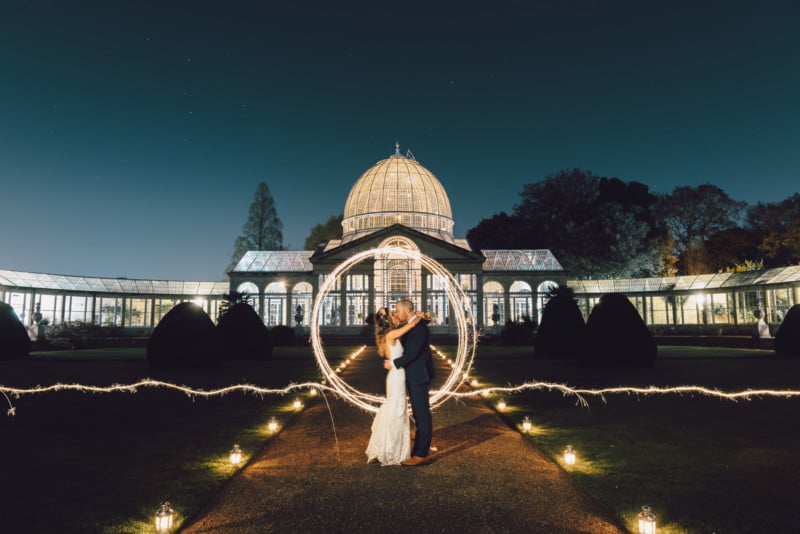
8. Look at the bigger picture
It’s easy to get tunnel vision when shooting a wedding, especially when shooting portraits, but try to stay aware of the surroundings you’re in. Buildings, landscapes, and natural features can be the key to producing memorable and creative photography. For example, when I was shooting a portrait session during one of the weddings that were part of the ‘Four Weddings’ documentary, I looked up and saw these amazing windows. For impact, I had our brides stand in separate windows. I stood quite far back and shot this at about 80mm on an AF-S NIKKOR 70-200mm f/2.8E FL ED VR lens.
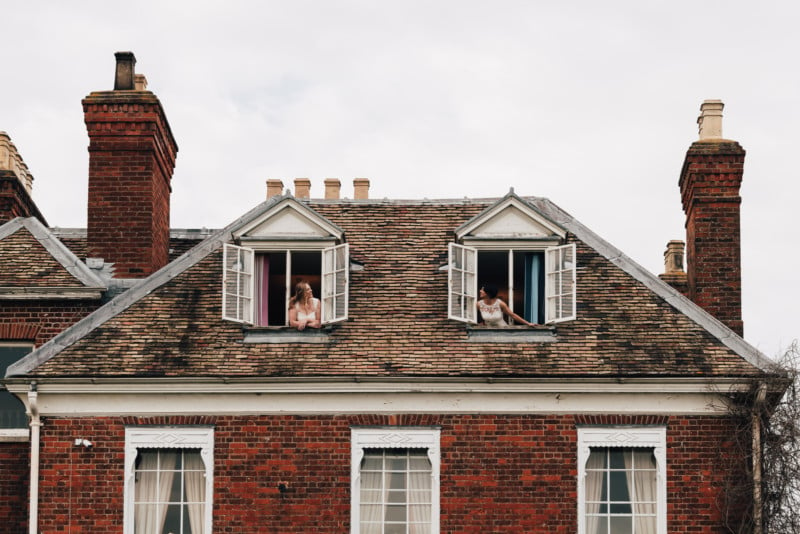
Regardless of what type of photographer you are or whether you’ve shot one wedding or one hundred, it’s always possible to do something different by putting yourself outside of your comfort zone.
Yes, you need to put the work in beforehand, have the right equipment and know-how, as well as having a Plan B. But if you’re in your comfort zone, the chances are you’re not pushing your creativity.
One of the best feelings is taking a risk with a shot then finding out that it worked. The next time you shoot a wedding, look for the obstacles and the bigger picture that no-one else can see. I guarantee that, if you do, you’ll create something amazing.
About the author: Will Patrick is a wedding photographer based in London, UK. The opinions expressed in this article are solely those of the author. You can find more of his work on his website, Facebook, Twitter, and Instagram.